Etude de bruit de fond induit par les muons dans l'expérience ...
Etude de bruit de fond induit par les muons dans l'expérience ...
Etude de bruit de fond induit par les muons dans l'expérience ...
Create successful ePaper yourself
Turn your PDF publications into a flip-book with our unique Google optimized e-Paper software.
tel-00724955, version 1 - 23 Aug 2012<br />
2<br />
40 Detecting the WIMP<br />
regime, even at very large WIMP-search exposures. This requires a powerful <strong>par</strong>ticle<br />
i<strong>de</strong>ntification technique that operates at low energies, but the benefits of lowbackground<br />
operation allow one to extract enormous sensitivity from relatively small<br />
<strong>de</strong>tector exposures in this way.<br />
Most mo<strong>de</strong>rn direct-<strong>de</strong>tection experiments use event-by-event discrimination techniques<br />
to i<strong>de</strong>ntify nuclear recoils from WIMPs, or neutrons, among a far larger rate of<br />
electron recoils from radioactive <strong>de</strong>cay and cosmogenic processes. Some experiments,<br />
notably bubble chambers and other phase-transition <strong>de</strong>tectors, use the difference in<br />
dE/dx between electron- and nuclear-recoil tracks to make their <strong>de</strong>tectors unresponsive<br />
to electron recoils, thus achieving a <strong>par</strong>ticularly simple sort of event-by-event<br />
discrimination. Discrimination is more commonly accomplished by measuring each<br />
event in two or more distinct <strong>de</strong>tection channels and using their ratio to i<strong>de</strong>ntify<br />
the recoil type. When the recoil occurs, the energy is <strong>par</strong>titioned in the ionization,<br />
the heat/phonons and the scintillation channels. In Figure 2.2, the main <strong>de</strong>tection<br />
techniques are shown around a triangle that <strong>de</strong>picts the energy from the interaction<br />
of a WIMP-nuclear recoil. These channels differ enormously in the mean nuclear recoil<br />
energy nee<strong>de</strong>d to create the individual quanta: A few meV per phonon, ∼ 10 eV<br />
per charge carrier, and ∼ 100 eV per scintillation photon. Each <strong>de</strong>tection technique<br />
exploits one or more of this channels or <strong>de</strong>grees of freedom to make the discrimination<br />
between nuclear recoils (neutrons and WIMPs) and electron recoils (majority<br />
of backgrounds).<br />
Xe, Ar,<br />
Ne<br />
NaI, Xe,<br />
Ar, Ne<br />
ZEPLIN II, III<br />
XENON<br />
WARP<br />
ArDM<br />
SIGN<br />
LUX<br />
NAIAD<br />
ZEPLIN I<br />
DAMA<br />
XMASS<br />
DEAP<br />
Mini-CLEAN<br />
Scintillation<br />
Few % of Energy<br />
Ge, CS2 , C3F8 DRIFT<br />
IGEX<br />
COUPP<br />
~20% of Energy<br />
Ionization<br />
Heat -<br />
Phonons<br />
CRESST II<br />
ROSEBUD<br />
CaWO4 , BGO<br />
ZnWO 4 , Al 2 O 3 …<br />
~100% of Energy<br />
CDMS<br />
EDELWEISS<br />
CRESST I<br />
Al 2 O 3 , LiF<br />
Ge, Si<br />
Figure 2.2: Main <strong>de</strong>tection techniques to track a WIMP signal. The triangle <strong>de</strong>picts<br />
the energy after a nuclear recoil interaction from a WIMP, each corner represents<br />
a channel where the energy from the interaction appears. Each <strong>de</strong>tection technique<br />
exploits one or more of these channels. Most of the energy goes into phonons and<br />
ionization, the two channels used by CDMS and EDELWEISS. Figure from [115].


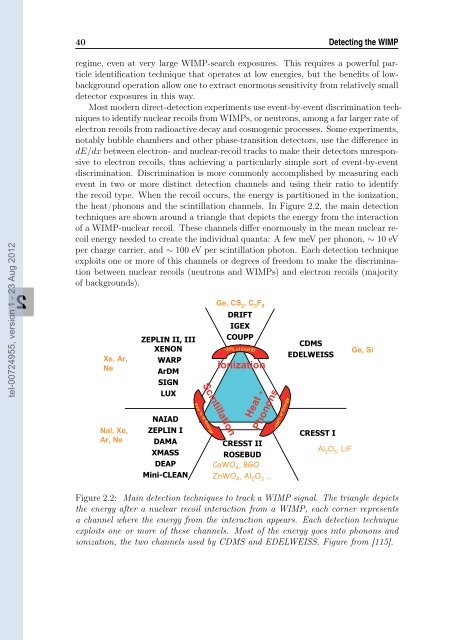

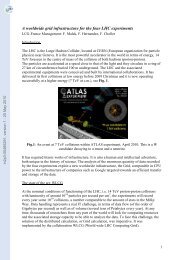

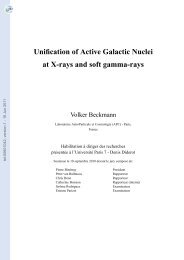

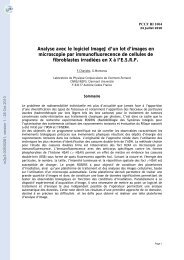
![[in2p3-00383985, v1] NUCLEAR PHYSICS at GANIL ... - HAL - IN2P3](https://img.yumpu.com/19016755/1/185x260/in2p3-00383985-v1-nuclear-physics-at-ganil-hal-in2p3.jpg?quality=85)
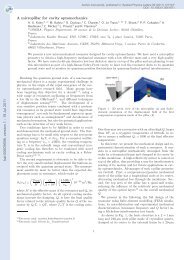
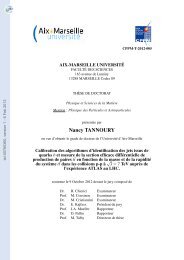
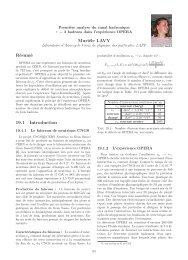
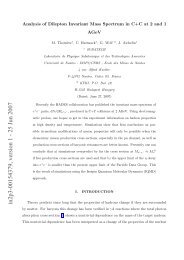
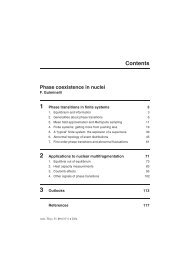
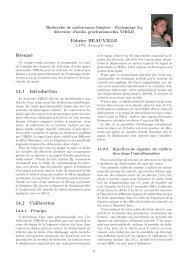
![[tel-00752304, v1] Pions réels et virtuels dans les noyaux](https://img.yumpu.com/19016523/1/184x260/tel-00752304-v1-pions-reels-et-virtuels-dans-les-noyaux.jpg?quality=85)